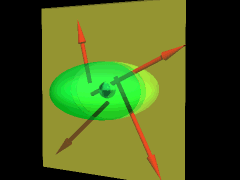| Ch 5. Rigid Body Equilibrium | Multimedia Engineering Statics | ||||||
|
2-D and 3-D Supports |
Equilibrium in 2-D |
Equilibrium in 3-D |
Indeterminate Objects | 2 and 3 Force Members | |||
| Equilibrium in 2-D | Case Intro | Theory | Case Solution | Example |
| Chapter |
| 1. Basics |
| 2. Vectors |
| 3. Forces |
| 4. Moments |
| 5. Rigid Bodies |
| 6. Structures |
| 7. Centroids/Inertia |
| 8. Internal Loads |
| 9. Friction |
| 10. Work & Energy |
| Appendix |
| Basic Math |
| Units |
| Sections |
| eBooks |
| Dynamics |
| Fluids |
| Math |
| Mechanics |
| Statics |
| Thermodynamics |
| ©Kurt Gramoll |
|
|
||
 Forces
|
For a rigid body in equilibrium, the sum of all the forces and the sum of all the moments must be zero, ΣF = 0 ΣM = 0 Using rectangular coordinates, these equations can be expressed by the vector equations, ΣF = ΣFxi + ΣFyj + ΣFzk = 0 ΣM = ΣMxi + ΣMyj + ΣMzk = 0 For the expanded equation, each coefficient of the i, j, and k unit vectors must equal zero for static equilibrium. ΣFx = 0 ΣFy = 0 ΣFz = 0 ΣMx = 0 ΣMy = 0 ΣMz = 0 The equilibrium equation has been separated into three components corresponding to the x, y, and z axes for both the forces and moments. Since each equation is independent of the others, the equations can be used to determine up to six unknowns for a full 3D problem. |
|
| Equilibrium Equations |
||
|
"Two-dimensional" is used to describe problems in which the forces reside in a particular plane (x-y for example), and the axes of all moments are perpendicular to the plane. Because there is no force in the z direction, and no moments about the x- or y-axis, three of the six independent scalar equations are automatically satisfied. The remaining equations for a rigid body in 2-D equilibrium are ΣFx = 0 ΣFy = 0 ΣMz = 0 Since there is a maximum of three independent equations for a rigid body in two-dimensional equilibrium, only three unknown forces or couples can be solved. |
||
